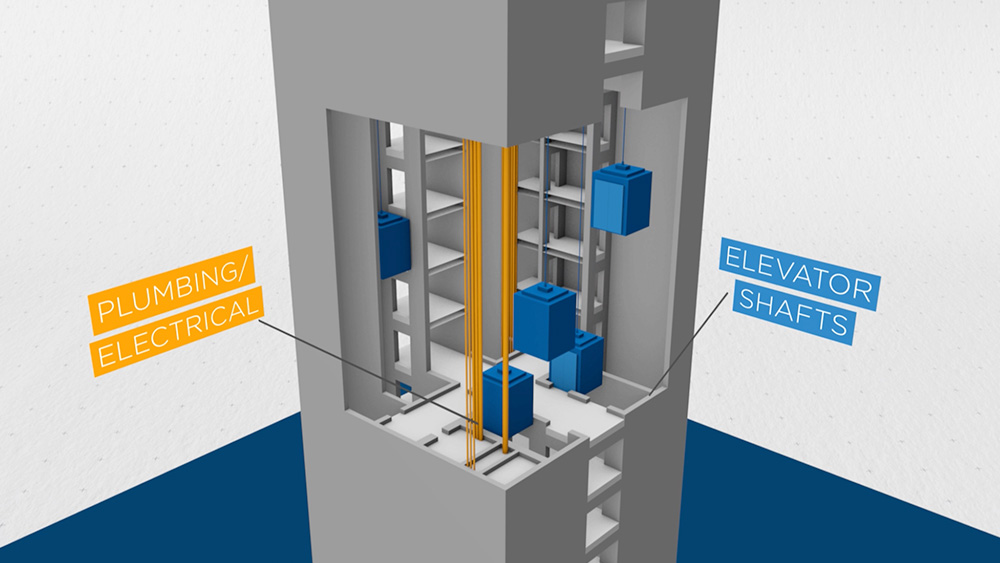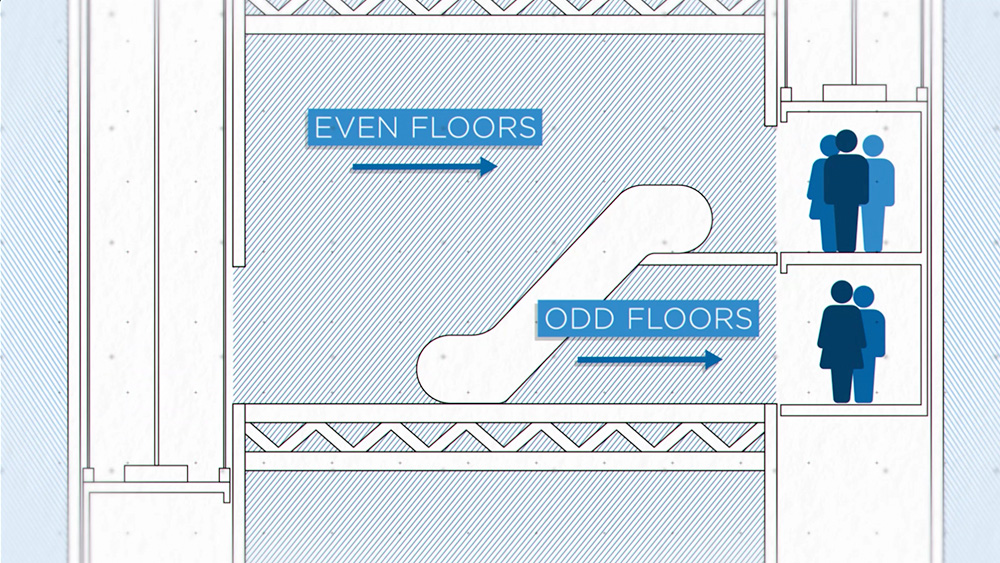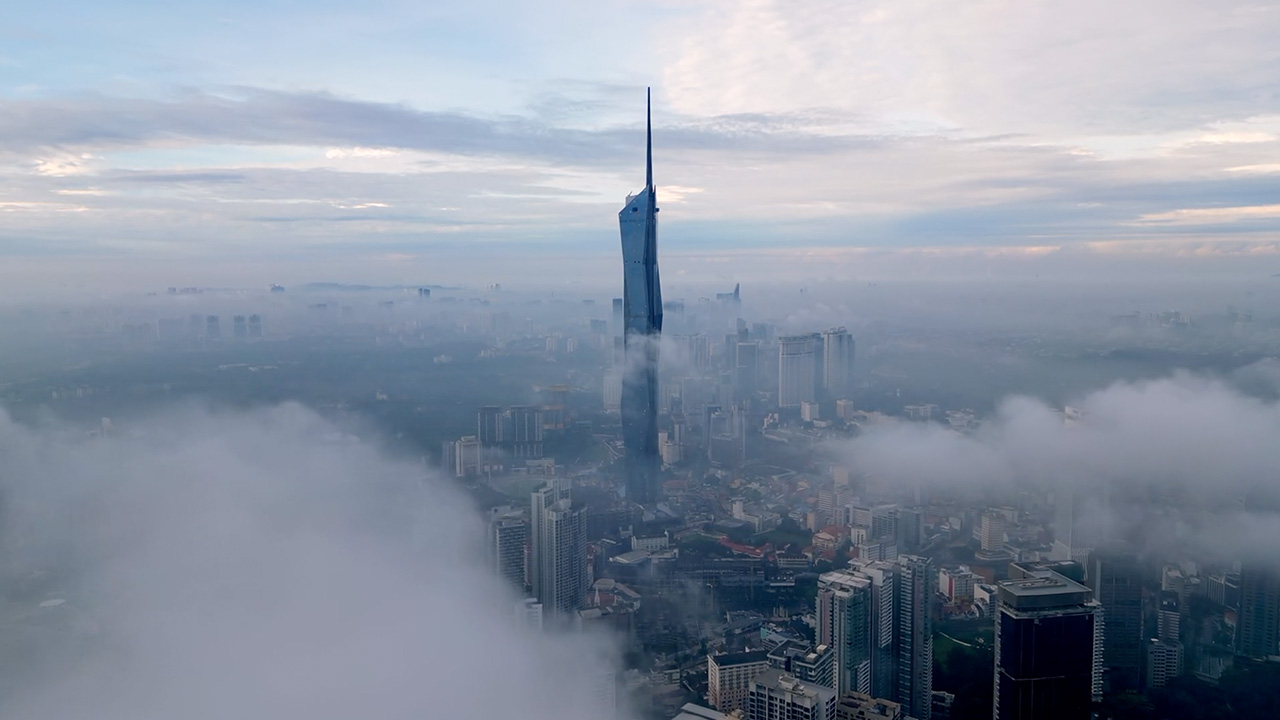Video narrated and hosted by Fred Mills. This video contains paid advertising for KONE.
When you think of big cities, places like New York, Dubai and Hong Kong probably come to mind, but Kuala Lumpur is right up there with them.
Malaysia is ranked 4th in the world in terms of the number of skyscrapers and 148 of them are located in KL. There is the Kuala Lumpur Tower, the impressive Exchange 106 and of course the iconic Petronas Towers, which were the tallest buildings in the world from 1998 to 2004.
But compared to Merdeka 118, all these buildings seem like mere bungalows. When its spire was completed in 2022, the building reached a height of over 600 meters, officially making it one of only four mega-skyscrapers on the planet. It is 678.9 meters tall, has 118 floors and will house around 10,000 people.

Above: Merdeka 118 rises through the clouds.
Such a large crowd sounds almost abstract, but to get an idea of what it feels like, take a short trip from Merdeka 118 to Bukit Bintang, the beating heart of Kuala Lumpur. Standing at the main intersection, it’s easy to be overwhelmed by the people whizzing past you in all directions in cars, on scooters and on the monorail. Now imagine squeezing all that into a small box in a very tall building.
This also highlights the age-old problem with skyscrapers. Tall buildings are built around a structural core that not only holds the whole thing upright, but also provides a great vertical access route through the tower. This is where you find the plumbing, power, other services, and most importantly, the elevator shafts – and the importance of elevators to the profitability of our tall buildings cannot be overstated. No one would want to go to the 118th floor if it meant climbing 118 flights of stairs.
Surrounding the core is the usable floor space, which can house hotels, offices, penthouses, or anything else the building is designed for. The problem with this is that the taller a building gets, the more floors are built, which in turn means more people need to use the building.
Putting in enough elevators to serve all those people means the core gets bigger and the usable floor space gets smaller. Soon, the available space inside the building shrinks so much that it’s no longer viable. So for a very tall building to make sense, engineers have to be clever and find ways to prevent the core from getting too big.

Above: The core of the skyscraper houses utilities such as pipes and elevator shafts.
To find out more, we spoke to Basil Carlo-Stella, APM Senior Vice President for New Building Solutions at KONE, the elevator company that helped make this massive building a reality:
“When you look at how people move around this building, it becomes pretty critical to their experience. And when you consider that there are 10,000 people in this building, it’s pretty important to think carefully about how they’re going to move.”
KONE installs elevators, escalators and all kinds of systems that support energy-efficient passenger transport everywhere. Their technology transports over a billion people around the world every day and shapes the future of life in cities. However, the world’s second tallest building forced them to take elevator technology to a new level.
To do this, they have developed a system that effectively divides the building into five zones. Each zone is served by a shuttle elevator that transports people from the ground floor into the building and into their zone at a speed of 10 meters per second.
From there, a series of commuter elevators take people to the specific floors they want to reach. If you work on level 94, you’ll take an express elevator directly to level 76 each morning, then transfer to a commuter car that serves each floor in that zone.
This approach allows you to effectively stack multiple elevator shafts in the building, preserving valuable floor space higher up in the building while still ensuring a pleasant experience for everyone in the building.
This is a proven method for making mega tall structures like this one commercially viable. KONE was brought in at the early design stage to help with the implementation, working with architects and engineers to design the core.
But at Merdeka 118, the development towards highly efficient passenger transport did not end there, because there is another simple way to double the capacity: double-deck elevators.
Carlo-Stella explains: “To put it simply, a double-decker elevator is essentially two elevators placed one above the other and connected to each other.”

Above: Passengers are divided into groups in local zones.
Once you reach your local zone, an AI-powered destination control system splits users into two groups. It sends passengers traveling to odd-numbered floors to the lower deck of the elevator, while those traveling to even-numbered floors are sent to the upper deck.
These double-decker elevators account for an incredible 37 of the 89 elevators used in Merdeka 118. Carlo-Stella specifically stresses how important these elevators are to the overall people flow strategy:
“Without this system, you would need a lot more elevators. So you suddenly see that the loss of revenue per square meter is quite significant.”
Pulling a double-decker elevator full of people into the world’s second tallest building requires sophisticated equipment, which is why KONE installed its MX100 elevator motors in Merdeka 118. These motors can lift a fully loaded, eight-ton elevator car at a speed of 10 meters per second.
But getting the motors into place is no easy task, as the motors themselves weigh seven tonnes. This requires careful coordination with the building’s main contractor, as the tower crane must lift the motors into place from street level before the floor is sealed.
But that’s not the only challenge during the construction phase. Even recruiting workers for such a large project before the high-speed elevators are installed can be a major challenge.
Typically, people and materials are moved up and down during construction using slower external elevators, called construction elevators. But there is fertile ground for efficiency here too. As a skyscraper grows upwards, KONE’s jumplifts can be installed in the lower parts of the completed elevator shafts in the main core.
A key consequence of this is that KONE Jumplifts can operate regardless of weather conditions. Conventional construction lifts are exposed to the elements and must stop operating for safety reasons in high winds or other extreme weather conditions.
When people keep moving on a construction site, less time is lost due to work interruptions, resulting in a more efficient and cost-effective project.
Four jump lifts were used at Merdeka 118, helping to transport 4,000 workers on one of the largest vertical construction sites in the world.

Above: Merdeka 118 under construction.
When you look at the extreme lengths construction crews are going to to build Merdeka 118, you have to ask yourself why. For decades, Kuala Lumpur has looked to the sky to create a sense of identity. But even taking that into account, Merdeka 118’s story is head and shoulders above all others.
To truly understand this story, we spoke to Tengku Dato Abdul Aziz, CEO of Merdeka Ventures, the owner and builder of the tower:
“For us, the Merdeka 118 Tower represents a new landmark for the city of Kuala Lumpur.
If you look at the silhouette of the building, you will see a spire on top of the tower representing the outstretched hand of the first Malaysian Prime Minister as he proclaimed “Merdeka”, which means “independence”.
Merdeka 118 takes a great moment in this country’s history and uses it to create a powerful, multi-layered and modern vision for the future. For Tengku Dato Abdul Aziz, Merdeka 118 will one day become as recognisable a landmark of Kuala Lumpur as the Eiffel Tower is to Paris or Burj Khalifa to Dubai.
This video and article contain paid advertising for KONE. Click here to learn how KONE is helping to shape future cities.
Video narrated and moderated by Fred Mills. Additional footage and images courtesy of Styfly, Columbia Pictures, KONE.

